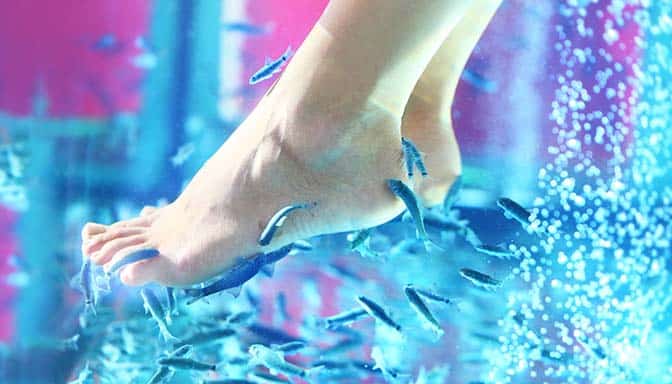A fish pedicure is an unconventional beauty treatment where individuals immerse their feet in warm water filled with small, toothless fish called Garra rufa. These fish gently nibble away at dead skin, offering a natural exfoliation process. Initially heralded for its novelty and purported health benefits, fish pedicures gained popularity across various spa and wellness centers in the United States.
However, the practice has faced scrutiny and regulatory challenges. Sanitation concerns, the health risks associated with communal water, and the potential for infections have led to the prohibition of fish pedicures in several states. Additionally, ethical questions regarding the treatment of the Garra rufa have been raised, influencing public perception and legal decisions around this service.

Key Takeaways
- Fish pedicures use Garra rufa fish to exfoliate feet.
- They are banned in several states due to health concerns.
- The practice raises both ethical and regulatory issues.
Overview of Fish Pedicures
Fish pedicures are a unique beauty treatment where participants dip their feet in tanks containing small fish that exfoliate the skin by eating dead cells.
History and Origins
The use of fish for pedicures traces back to ancient practices in the Middle East, particularly in Turkey, where the Garra rufa fish, also known as “doctor fish,” originated. These fish therapies were believed to alleviate skin conditions, leading to their incorporation into modern spa treatments.
Popularity Trends in the USA
In the United States, fish pedicures gained attention in the late 2000s as a novel spa experience. Despite initial interest, regulation and health concerns have resulted in bans in several states, impacting their overall popularity.
Types of Fish Used
The primary species used for fish pedicures is the Garra rufa. These toothless fish gently remove dead skin, offering a natural exfoliation process. Some enterprises have improperly used other species, like the Chin Chin fish, which led to additional health concerns.
New Fish Spa Experiences
The charm of fish spa experiences continues to captivate a global audience, offering a unique combination of natural fish interactions and a delightful sensory experience. As the treatment gains acclaim, its roots in ancient practices are celebrated.
At the same time, the modern embrace of fish spa experiences marks a convergence of historical wellness rituals with contemporary desires for novel and natural experiential experiences.
The fish spa experience, with its positive and uplifting effects, has become a symbol of confidence in nature’s own methods of care, providing a knowledgeable escape into the world of holistic well-being. Read all about Garra Rufa Fish Spa Experiences.
Legal and Regulatory Considerations
In the United States, the legality of fish pedicures is determined by individual state regulations, which often hinge on the interpretation of health and safety guidelines.
State Regulations
Several states have outright banned fish pedicures due to sanitation and animal welfare concerns. For instance, legislation has been enacted in at least 15 states where these services can no longer be offered. In particular, fish pedicures are not permissible within these jurisdictions, as they have been determined to violate standards set for beauty treatments.
For example, Texas regulations specify the avoidance of using live animals in cosmetology services. Some online sources report 22 states that have fish pedicures banned. They include Alabama, Arizona, California, Colorado, Florida, Georgia, Iowa, Massachusetts, Mississippi, Montana, Nevada, New Hampshire, New Jersey, New York, Oklahoma, Pennsylvania, South Dakota, Tennessee, Texas, Utah, Washington, and Wisconsin. Some states, like Nevada, appear to be allowing consideration of whether certain parameters can be met.
Health and Safety Guidelines
The primary health concern with fish pedicures centers on the inability to sufficiently sanitize the fish between customers, posing potential risks of transmitting infections. Health guidelines emphasize the importance of disinfecting tools and equipment in beauty treatments.
This measure is unfeasible when applied to living creatures like the Garra rufa fish, which is commonly used. These guidelines foster an environment that prioritizes consumer safety and public health, leading to the controversy surrounding fish pedicures and their subsequent bans across numerous states.
Health Benefits and Risks
In assessing fish pedicures, one weighs the potential skin health benefits against the concerns for medical safety that experts and regulatory bodies have expressed.
Reported Benefits
Reported benefits of fish pedicures center on their ability to exfoliate the skin, potentially resulting in smoother feet with reduced callouses. The Garra rufa fish, also known as “doctor fish,” are said to eat away dead skin, which proponents argue leads to improved circulation and stress reduction.
Potential Health Risks
However, the potential health risks associated with fish pedicures include infections from bacteria in the water or the fish’s transmission between clients. Some of these bacterial strains can be resistant to antibiotics, posing a significant risk to individuals with compromised immune systems. Regulatory agencies like the Texas Department of Licensing and Regulation have cited sanitary concerns as grounds for banning the practice in several states.
Expert Opinions
Dermatologists and healthcare professionals often express caution regarding fish pedicures. The lack of disinfection between clients, as fish cannot be sanitized, has led experts to question the practice’s safety.
Moreover, there is skepticism about the long-term skin health effects, with some specialists emphasizing that traditional pedicures at credible salons offer similar benefits without the associated risks outlined by medical professionals at the Cleveland Clinic and other institutions concerned with public health and safety.

Fish Pedicure Procedure
Fish pedicures involve a distinct process where one soaks their feet in a basin containing Garra rufa fish, which gently removes dead skin through their nibbling action.
Preparation Process
Before a fish pedicure commences, patrons typically have their feet thoroughly cleaned to remove any lotions, oils, or debris. This step is crucial as cleanliness ensures the customer’s and fish’s health and safety. Some spas may also inspect the client’s feet for open wounds or infections, declining service if any issues are detected to avoid health risks.
During the Procedure
During the fish pedicure, individuals immerse their feet into a tank, allowing the Garra rufa fish to exfoliate the skin. This treatment can last anywhere from 15 to 30 minutes, depending on the spa’s practices and the customer’s preference. The sensation is often described as a light tickling or gentle nibbling.
Post-Procedure Care
After the procedure, it is important to rinse the feet with clean water to remove any remaining skin fragments. Patrons should then dry their feet thoroughly. Some spas provide moisturizing treatments to rehydrate the skin after the exfoliation. Proper post-procedure hygiene is enforced to prevent any potential infections.
Ethical Considerations
Fish pedicures have grown in popularity, yet they pose significant ethical considerations. They have sparked a debate concerning animal welfare and sustainability in the beauty industry.
Animal Welfare Concerns
Garra rufa, the fish often used in pedicures, faces questionable living conditions that concern many animal rights activists. The ethical implications arise from the fish being starved to encourage them to eat dead skin off customers’ feet, a practice described in articles such as Fish Pedicures Banned in 10 Different States: The Controversy Explained. The welfare of these fish is often sidelined for commercial gain, leading to widespread criticism.
Sustainability Issues
The sustainability of the fish pedicure industry is another pressing concern. The repeated use of the same fish across multiple clients and the lack of individual fish care can lead to disease and environmental degradation. Detailed in a Healthline article, Fish Pedicure: Risks, Benefits, Safety, and Ethical Concerns, the threat to both local ecosystems and the well-being of the fish populations is a matter for serious consideration.
Business Perspectives
In the United States, the fish pedicure industry presents complex business challenges due to varying regulations and consumer concerns. Entrepreneurs interested in this niche must navigate the legal landscape, market viability, and customer acquisition techniques.
Market Analysis
The demand for fish pedicures fluctuates across different states, influenced by novelty appeal and wellness trends. Data suggests that in regions where fish pedicures are legal, they often capture the curiosity of consumers seeking unique spa experiences.
Businesses must assess the local regulatory climate and consumer sentiment to determine if a market exists for this service. Legality and customer perception often dictate market size and potential growth; hence, comprehensive analysis is paramount for prospective business owners.
Starting a Fish Pedicure Business
Opening a fish pedicure business necessitates a strategic approach. Entrepreneurs must secure a suitable location, accounting for factors like foot traffic and local demographics, and invest in quality equipment, ensuring the fish’s and customers’ health and safety. They must also navigate complex regulatory requirements that vary by state, including specific licensing and operational standards, to avoid penalties and ensure consumer safety.
Critical Steps:
- Location Selection: Accessibility and visibility are crucial.
- Equipment and Supplies: Quality tanks and healthy fish are non-negotiable for industry success.
- Legal Compliance: Adhering to state laws and regulations to avoid business disruptions or closures.
Customer Acquisition Strategies
For fish pedicure businesses, attracting and retaining customers is influenced by effective marketing and exceptional service. A strong online presence, through a professional website and savvy use of social media, can attract initial customers. Additionally, leveraging local press and wellness blogs, especially those with an emphasis on unique spa treatments, can drive interest. Customer experience is paramount, and positive word-of-mouth remains a powerful tool to acquire and maintain a loyal customer base.
- Digital Marketing: Utilize social media and SEO to increase visibility.
- Local Partnerships: Engage with nearby businesses for cross-promotion.
- Customer Experience: Prioritize high-quality service to encourage repeat visits and referrals.
Consumer Experiences
Customer experiences with fish pedicures in the USA reflect a spectrum of opinions and highlight differences when compared to traditional pedicure methods.
Customer Reviews
Customers who have tried fish pedicures often describe the experience as unique and ticklish. Reviews typically mention the novelty of having small fish, commonly Garra rufa, gently nibble away dead skin, which some found to be an amusing alternative to scrubbing or chemical exfoliation.
However, there are instances where individuals report discomfort or dissatisfaction, mainly due to personal sensitivity to the fish’s sensation on their skin or skepticism about the hygiene practices of certain spas.
Comparisons With Traditional Pedicures
- Experience: Fish pedicures are frequently described as more gentle than traditional pedicures that use abrasive tools.
- Results: Some consumers assert that fish pedicures leave their feet feeling as smooth as a standard pedicure, while others have not noticed a significant difference.
- Health and Safety: Consumers have an ongoing discussion regarding the health and safety of fish pedicures. Concerns center around the potential for infection and the inability to sanitize the fish between clients.
Frequently Asked Questions
This section concisely overviews common inquiries regarding fish pedicures, addressing health concerns, skin benefits, pricing, availability, preparation, and aftercare.
What are the risks of undergoing a fish pedicure?
Fish pedicures carry potential risks, such as bacterial infections stemming from improper sanitization and the inability to disinfect the fish between uses. Animal welfare concerns also arise regarding the treatment of the Garra rufa fish utilized in these procedures. More information on the associated risks, including concerns surrounding animal safety, can be found in an article by the Cleveland Clinic.
How does a fish spa treatment benefit the skin?
A fish pedicure uses Garra rufa fish to exfoliate the skin, which can yield smoother skin and reduce calluses. The fish gently nibble away dead skin, which proponents claim can rejuvenate the appearance of the feet.
What are the typical costs associated with a fish pedicure?
The cost of a fish pedicure can vary widely, typically ranging from $30 to $70, depending on the location and duration of the treatment. Spa amenities and the region of the spa can also affect the pricing of these unique treatments.
Where can one find Garra fish spa services in the United States?
While fish pedicures became popular in some spa locations, they have been banned in several states due to health and ethical concerns. Interested individuals should check local regulations and find related services in certain states where it remains legal.
How should one prepare for a fish pedicure session?
Preparing for a fish pedicure involves ensuring that feet are clean and free of any wounds or infections. It is important not to apply lotions or oils beforehand as these can harm the fish or contaminate the water.
Are there any aftercare recommendations for post-fish pedicure treatment?
After undergoing a fish pedicure, it is recommended to rinse the feet with clean water to remove any remnants from the treatment. Moisturizing the feet after the session can maintain the softness achieved from the fish pedicure.



